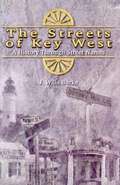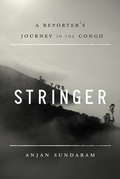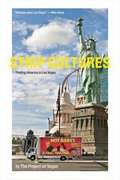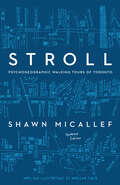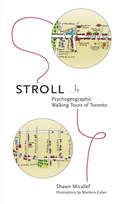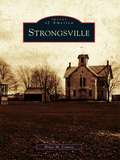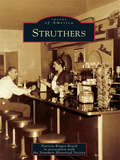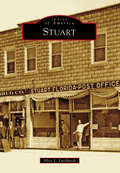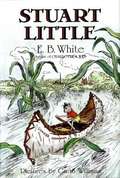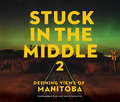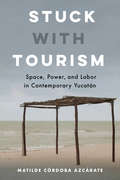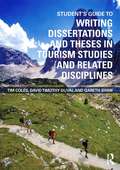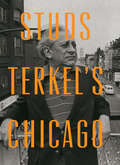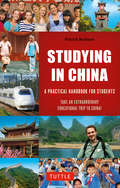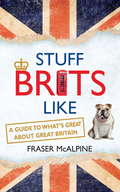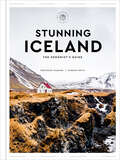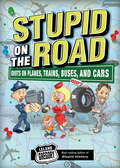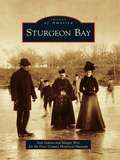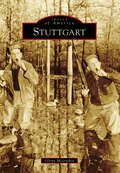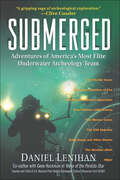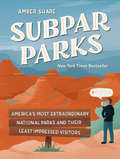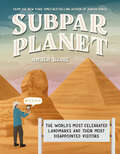- Table View
- List View
Streets of Key West: A History Through Street Names
by J Wills BurkeSimonton, Duval, Eaton, Whitehead, Southard, Truman—if you discover how these Key West streets, and all the others, came by their names, you will know much of the history of this little island at the nethermost end of the continental United States. You will learn of the rise and fall and rise again of the fortunes of this island town, which has played such a rich role in the history of the country as a whole. The author starts each section with an engaging history of the person for whom the street is named. Then he takes us along the street, pointing out the buildings and sites of historic interest along the way. This method builds and reinforces our grasp of Key West's history as the island is crisscrossed with sites that evoke nearly every aspect of its past. What emerges is a unique and quirky history of Key West, as well as a fascinating guide to wandering its streets, boulevards, alleys, and lanes.
Stringbean's Trip to the Shining Sea
by Vera B. Williams Jennifer WilliamsStringbean describes his trip to the west coast in a series of postcards.
Stringer
by Anjan SundaramIn the powerful travel-writing tradition of Ryszard Kapuscinski and V.S. Naipaul, a haunting memoir of a dangerous and disorienting year of self-discovery in one of the world's unhappiest countries.
Strip Cultures: Finding America in Las Vegas
by The Project on VegasOn the Las Vegas Strip, blockbuster casinos burst out of the desert, billboards promise "hot babes," actual hot babes proffer complimentary drinks, and a million happy slot machines ring day and night. It's loud and excessive, but, as the Project on Vegas demonstrates, the Strip is not a world apart. Combining written critique with more than one hundred photographs by Karen Klugman, Strip Cultures examines the politics of food and water, art and spectacle, entertainment and branding, body and sensory experience. In confronting the ordinary on America's most famous four-mile stretch of pavement, the authors reveal how the Strip concentrates and magnifies the basic truths and practices of American culture where consumerism is the stuff of life, digital surveillance annuls the right to privacy, and nature--all but destroyed--is refashioned as an element of decor.
Stroll, updated edition: Psychogeographic Walking Tours Of Toronto
by Shawn MicallefTHE TORONTO STAR'S "30 BOOKS WE CAN'T WAIT TO READ THIS SPRING"The updated edition of a Toronto favourite meanders around some of the city’s unique neighborhoods and considers what makes a city walkable What is the 'Toronto look'? Glass skyscrapers rise beside Victorian homes, and Brutalist apartment buildings often mark the edge of leafy ravines, creating a city of contrasts whose architectural look can only be defined by telling the story of how it came together and how it works, today, as an imperfect machine.Shawn Micallef has been examining Toronto’s streetscapes for decades. His psychogeographic reportages situate Toronto's buildings and streets in living, breathing detail, and tell us about the people who use them; the ways, intended or otherwise, that they are being used; and how they are evolving.Stroll celebrates Toronto's details – some subtle, others grand – at the speed of walking and, in so doing, helps us to better get to know its many neighbourhoods, taking us from well-known spots like the CN Tower and Pearson Airport to the overlooked corners of Scarborough and all the way to the end of the Leslie Street Spit in Lake Ontario."Shawn Micallef is the unofficial mayor of Toronto, the genial ambassador the city needs and deserves. As he strolls Toronto’s broad avenues and its little streets, he finds hidden pockets of delight – and weirdness, too. Join him and fall in love with the city again." – Liz Renzetti, author of Bury the Lead"When I moved to Toronto in 2011, Stroll was the first book I added to my library and course reading lists. My students and I get lost in the PATH, sneak into lobbies, and visit the archives with this book as our guide. Micallef’s friendly voice invites us to slow down and notice not just a few landmark buildings but the city’s built fabric as a whole. This updated version offers our collective memory a much-needed affectionate yet critical view of recent changes to the city." – Erica Allen-Kim, Author of Building Little Saigon"Stroll is a delightful and eccentric guidebook, full of clever writing, amusing stories and charming maps that will make you want to strap on your walking shoes and head into the streets of Toronto." – Carol Off, Author/Broadcaster"Shawn Micallef looks at the city in a way we all should more often – he sees it as a living book that is alive with stories just waiting to be told to the attentive observer. In Stroll, he gives us an introduction to just how interesting and surprisingly dramatic those stories are, and how exciting our city is when we hear them." – David Crombie, former mayor of Toronto"A smart and intimate guide to the city that makes you feel like an insider from start to finish." – Douglas CouplandThis new edition updates things in the city that have changed and includes several new walks.
Stroll: Psychogeographic Walking Tours of Toronto
by Marlena Zuber Shawn MicallefWhat is the 'Toronto look'? Glass skyscrapers rise beside Victorian homes, and Brutalist apartment buildings often mark the edge of leafy ravines, creating a city of contrasts whose architectural look can only be defined by telling the story of how it came together and how it works, today, as an imperfect machine. Shawn Micallef has been examining Toronto's streetscapes for a decade. His psychogeographic reportages, some of which have been featured in EYE WEEKLY and Spacing magazine, situate Toronto's buildings and streets in living, breathing detail, and tell us about the people who use them; the ways, intended or otherwise, that they are being used; and how they are evolving. Stroll celebrates Toronto's details - some subtle, others grand - at the speed of walking and, in so doing, helps us to better get to know its many neighbourhoods, taking us from well-known spots like the CN Tower and Pearson Airport to the overlooked corners of Scarborough and all the way to the end of the Leslie Street Spit in Lake Ontario. Stroll features thirty-two walks, a flâneur manifesto, a foreword by architecture critic John Bentley Mays and dozens of hand-drawn maps by Marlena Zuber. 'Shawn Micallef looks at the city in a way we all should more often - he sees it as a living book that is alive with stories just waiting to be told to the attentive observer. In Stroll, he gives us an introduction to just how interesting and surprisingly dramatic those stories are, and how exciting our city is when we hear them.' - David Crombie, former mayor of Toronto. 'A smart and intimate guide to the city that makes you feel like an insider from start to finish.' - Douglas Coupland. Stroll is co-published with EYE WEEKLY.
Strongsville (Images of America)
by Bruce M. CoureyStrongsville was originally organized in 1818 as Strongsville Township, named for its founder, John Stoughton Strong, and comprised of a 25-square-mile area of the Connecticut Western Reserve. The first roads, schools, churches, mills, and taverns emerged soon after, and the township's population grew to 297 by 1820. For 120 years, up until World War II, farming and agriculture characterized the area. Incorporated as a village in 1927 and as a city in 1961, Strongsville underwent dramatic evolution and growth during the last quarter of the 20th century, particularly under the leadership of longtime mayor Walter F. Ehrnfelt. Strongsville has grown from a quiet, rural town into one of northeastern Ohio's largest and most vibrant communities. It is known throughout the Greater Cleveland area as a community that offers its residents all the amenities of a large municipality while maintaining its small-town charm.
Struthers
by Patricia Ringos Beach Struthers Historical SocietyStruthers is the story of a small town in northeastern Ohio. The town began with the stumbling start of John Struthers as he chased a band of marauding Native Americans through the valley. He later came to settle in what would eventually be Yellow Creek Park. He lost a son and most of his fortune after the War of 1812. Later another son, Thomas, would return as a wealthy entrepreneur to reclaim the family land in his father's memory and help develop the town. The steel industry played a large role in shaping Struthers, as have Yellow Creek Park and Lake Hamilton by offering its hardworking residents places of beauty to relax and enjoy. The historic images in this book capture moments in everyday life in Struthers, from its incorporation to present day. This book is for longtime residents, newcomers, and passersby alike so they may treasure and remember Struthers's history for years to come.
Stuart (Images of America)
by Alice L. LuckhardtOn the southeast coast of Florida in the 1880s, a quaint little community was nestled along the tranquil waters of the St. Lucie River in a wilderness of tropical beauty, one of the region's last frontiers. As lucrative pineapple crops and the commercial fishing industry began to flourish, trade boats brought necessary supplies, and new settlers arrived on river steamers. With land available for homesteading or for sale at $1.25 an acre, the small village soon to be known as Stuart would become a mecca for innovative, hardworking young men seeking business and financial opportunities. By the dawn of the 20th century, the railroad had been established, and the town, forged by the fortitude of early pioneers, thrived, eventually becoming a beautiful, friendly incorporated city.
Stuart Little
by E. B. WhiteStuart Little is no ordinary mouse. Born to a family of humans, he lives in New York City with his parents, his older brother George, and Snowbell the cat. Though he's shy and thoughtful, he's also a true lover of adventure. Stuart's greatest adventure comes when his best friend, a beautiful little bird named Margalo, disappears from her nest. Determined to track her down, Stuart ventures away from home for the very first time in his life. He finds adventure aplenty. But will he find his friend?
Stuck in the Middle 2: Defining Views of Manitoba (Stuck In The Middle)
by Bartley Kives Bryan Scott"a compelling look at virtually every corner of our vast province." - Winnipeg Free Press"Weird and breathtaking: Book showcases Manitoba views through a different lens" - The Metro: Winnipeg Somewhere between North Dakota and Nunavut sits a curious land with a coastline patrolled by polar bears, highways lined with monuments to household produce and dinner plates drenched in a gluey condiment known as honey dill sauce. This is Manitoba, a province that has captured the imagination of... well, maybe dozens of people around the world. Stuck In The Middle 2 finds photographer Bryan Scott and journalist Bartley Kives venturing beyond the Perimeter Highway to explore the architecture, landscapes and waterways of a province they know and love but, like most Manitobans, may never truly understand.
Stuck with Tourism: Space, Power, and Labor in Contemporary Yucatan
by Matilde Córdoba AzcárateTourism has become one of the most powerful forces organizing the predatory geographies of late capitalism. It creates entangled futures of exploitation and dependence, extracting resources and labor, and eclipsing other ways of doing, living, and imagining life. And yet, tourism also creates jobs, encourages infrastructure development, and in many places inspires the only possibility of hope and well-being. Stuck with Tourism explores the ambivalent nature of tourism by drawing on ethnographic evidence from the Mexican Yucatán Peninsula, a region voraciously transformed by tourism development over the past forty years. Contrasting labor and lived experiences at the beach resorts of Cancún, protected natural enclaves along the Gulf coast, historical buildings of the colonial past, and maquilas for souvenir production in the Maya heartland, this book explores the moral, political, ecological, and everyday dilemmas that emerge when, as Yucatán’s inhabitants put it, people get stuck in tourism’s grip.
Student's Guide to Writing Dissertations and Theses in Tourism Studies and Related Disciplines
by David Timothy Duval Gareth Shaw Tim ColesAround the world every year very many students have to complete dissertations or theses as part of their undergraduate or masters studies in tourism and related subjects. Often this substantial piece of self-directed work is the culmination of their programmes. More than just a means to consolidate their final grades, it is also an exciting chance to research a topic of their choosing and a potential gateway to more advanced study as well as job offers and future career paths. Yet for all these reasons, many students view the dissertation as a tricky challenge. This comprehensive book intends to take the stress and anxiety out of doing a dissertation in tourism studies and related disciplines. The process is examined from the germination of an idea to the submission and assessment of the final document. Written primarily for students conducting independent research for the first time, this book offers simple advice and a clear framework which students can adopt even in more advanced studies at masters and doctoral level. This book debunks popular myths, and aims to overcome common pitfalls. It focuses on the aims and objectives as the DNA of every dissertation. Rather than view it as a single, overwhelming project, the dissertation is presented as a series of more modest, manageable yet crucially inter-linked tasks that all students can successfully complete through careful preparation and effective time management. Dissertations are not to be underestimated and they demand great care and attention, but they can also be immensely rewarding and enriching experiences academically and personally. This ‘jargon free’ book is also written with overseas students specifically in mind, drawing directly on our overseas students’ experiences. This valuable resource contains start of chapter learning objectives and end of chapter checklists, as well as numerous boxed case studies, to further help assist students through their dissertation.
Studies in the Social and Cultural History of Modern Warfare: Allies in Memory
by Sam EdwardsAmidst the ruins of postwar Europe, and just as the Cold War dawned, many new memorials were dedicated to those Americans who had fought and fallen for freedom. Some of these monuments, plaques, stained-glass windows and other commemorative signposts were established by agents of the US government, partly in the service of transatlantic diplomacy; some were built by American veterans' groups mourning lost comrades; and some were provided by grateful and grieving European communities. As the war receded, Europe also became the site for other forms of American commemoration: from the sombre and solemn battlefield pilgrimages of veterans, to the political theatre of Presidents, to the production and consumption of commemorative souvenirs. With a specific focus on processes and practices in two distinct regions of Europe – Normandy and East Anglia – Sam Edwards tells a story of postwar Euro-American cultural contact, and of the acts of transatlantic commemoration that this bequeathed.
Studs Terkel's Chicago
by Studs TerkelIn a blend of history, memoir, and photography, the Pulitzer Prize winner paints a vivid portrait of this extraordinary American city. Chicago was home to the country&’s first skyscraper (a ten-story building built in 1884), and marks the start of the famed Route 66. It is also the birthplace of the remote control (Zenith) and the car radio (Motorola), and the first major American city to elect a woman (Jane Byrne) and then an African American man (Harold Washington) as mayor. Its literary and journalistic history is just as dazzling, and includes Nelson Algren, Mike Royko, and Sara Paretsky. From Al Capone to the street riots during the Democratic National Convention in 1968, Chicago, in the words of Studs Terkel, &“has—as they used to whisper of the town&’s fast woman—a reputation.&” Chicago was also home to Terkel, the Pulitzer Prize–winning oral historian, who moved to Chicago in 1922 as an eight-year-old and who would make it his home until his death in 2008 at the age of ninety-six. This book is a splendid evocation of Studs Terkel&’s hometown in all its glory—and all its imperfection.
Studying in China
by Patrick Mcaloon"China is changing faster than any other nation on earth today. Written by a Chinese language teacher and a travel professional who works with students in China all the time, Studying in China is an invaluable resource. . . "—Chinese Language Teachers Association (CLTA) Newsletter A visit to China can change your life. Would you like to study in China, but are not sure what you will find there? A trip to China to live, work or study promises an amazing, life-changing experience in the most historically and culturally fascinating nation on earth. Find all the information you need for your educational experience abroad in Studying in China. Readying yourself for this experience can be daunting, and Studying in China makes it easy from start to finish. Prepare to make new friends in your classes and while traveling around China, but first learn how to avoid common pitfalls and mistakes. Being an international student in China can be a life-changing experience. Don't take our word for it. Read this book and go study in China!
Studying in China
by Patrick McaloonA visit to China can change your life.Have you thought about studying in China, but are not sure what you will find there? A trip to China to live, work or study promises an amazing, life-changing experience in the most historically and culturally fascinating nation on earth. Find all the information you need for your educational experience abroad in Studying in China.China is changing faster than any other nation on earth today. Written by a travel professional who works with students in China all the time, Studying in China is an invaluable resource that tells you: What to pack that you won't find over there How to arrive at your destination and settle in safely How to make your Chinese instructors happy How your day-to-day experiences will unfold once you are there How to get the most from a limited stayAuthor Patrick McAloon is a co-founder of SinoConnect, a firm that connects students of all ages with educational opportunities in China and the United States. He has been helping students prepare to study in China for 15 years. Having conducted hundreds of study abroad seminars, McAloon is uniquely qualified to supply students going to China with the latest up-to-date information on how to study abroad.Readying yourself for this experience can be daunting, and Studying in China makes it easy from start to finish. Prepare to make new friends in your classes and while traveling around China, but first learn how to avoid common pitfalls and mistakes. Being an international student in China can be a life-changing experience. Don't take our word for it. Read this book and go!
Stuff Brits Like: A Guide to What's Great about Great Britain
by Fraser McAlpineAs the lead writer for BBC Anglophenia, Fraser McAlpine (a man assembled from almost every region of the UK*) spends his life explaining Brits to foreigners. Now he lifts the lid on our Marmite pot of nations and takes you on a journey from the Isle of Wight to Inverness, Belfast to Bangor, exploring the joyful enthusiasms (and pet hates) of an endlessly multifarious Britain. Stuff Brits Like celebrates why we like puns and pedantry, decorum and drawing willies on things, Trainspotting and Downton Abbey, apologizing needlessly (sorry) and cocking a snook. We cheer both the underdog and the bad guy, we adore melancholy types like Morrissey and grumpy Eeyore... and we love being told off by scolds. Meet mythical beasts from the Scottish Nuckelavee to the Cornish Knocker; the branch of the WI called the Iron Maidens, and the British Cheese Board (yes, it is really called that); find out which eccentric Lord would only eat his meals in his swimming pool, why postboxes are bright red (it's health and safety gone mad) and the origin of weird traditions such as the Burning of the Clocks. Stuff Brits Like takes you through why Doctor Who could only have come from Britain, why cricket is a form of siege warfare in whites, and why we argue about the best five British films or what makes The Great British Guitar Band...
Stunning Iceland: The Hedonist's Guide
by Bertrand Jouanne Gunnar FreyrGo beyond the ordinary with this remarkable travelogue, guidebook, and coffee table keepsake filled with spectacular color photography that showcases Iceland’s stunning beauty and hidden gems, from its fjords and highlands to the Western Islands and the capital Reykjavik—the first entry in the Hedonist’s Guide travel series.Combining essential insider details, cultural information, must-see attractions, and detailed maps with glorious custom photography, Stunning Iceland is the ultimate handbook for modern nomads, including both savvy travelers and novice tourists. Designed for twenty-first century globetrotters, Stunning Iceland features stylish graphics and an elegant visual design, as well as a breakdown of must-visit places, thematic double-page photographic spreads to help you discover and understand the city, and walking routes to explore each district away from the crowds. Whether you prefer a more traditional visit or want to chart your own unique course, this user-friendly handbook includes everything you need—and more:Discover the charm of a luxury ecolodge surrounded by natureMeet the surfers of the ArcticTaste the new Nordic gastronomyFollow in the footsteps of the heroes of the Icelandic sagasMeet the polar fox and the blue whaleBathe in the natural hot springsAdmire the Icelandic floraLearn about the battle between the tectonic plates beneath Iceland and its active volcanoesExperience Reykjavík, the nation’s beating heart Stunning Iceland offers inspiration and insight for armchair travelers and dreamers alike. Best of all, the gorgeous photography transforms the book into a keepsake that will transport you back to your favorite places and sights long after returning home.Experience Iceland as never before with the Hedonist’s Guide!
Stupid on the Road: Idiots on Planes, Trains, Buses, and Cars (Stupid History #7)
by Leland GregoryThe bestselling chronicler of human stupidity shares tales of unruly passengers, dumb drivers, and the people who put the &“loco&” in locomotive . . . New York Times-bestselling author Leland Gregory presents a riotous collection of the unbelievably bizarre events and behavior that result when people strap themselves in for a ride. Gregory, who has so entertainingly highlighted humanity&’s stupidity in the areas of crime, business, love, politics, and more—now turns his attention to idiots on the road, on the rails, and in the air. From mind-boggling insurance claims (&“A pedestrian hit me and went under my car&”), to the cops who went after an erratic driver and found an iguana at the wheel, to the overweight woman who thought the airline purposely put a tag calling her &“FAT&” on her luggage (it was the airport code for Fresno), these true stories ranging from the horrifying to the hilarious will have you shaking your head at the misadventures that have occurred as people attempt to get from point A to point B.
Sturgeon Bay
by Door County Historical Museum Ann Jinkins Maggie WeirStretching midway across Wisconsin's famous Door County peninsula, Sturgeon Bay has developed into the county's business and industrial center. Divided by the waterway it's named after, this small city provided a home to a working waterfront that once housed sawmills and docks for shipping ice, quarried stone, and, later, cherries. A canal dug from Sturgeon Bay to Lake Michigan in 1880 enabled ships to avoid the long passage over the tip of the peninsula. Sturgeon Bay became a shipbuilding capital, housing three major yards. The lively downtown districts on each side of the bay sported the typical hotels, taverns, stores, and blacksmith shops. Residents took pride in their newly formed schools, churches, and public services such as the Pioneer Fire Department. Families, fortunate to live in a land of great natural beauty, enjoyed recreational pursuits in the woods and on the water, whether it was perch fishing early on a summer morning or skating over the ice on a crisp winter afternoon.
Stuttgart (Images of America)
by Glenn MosenthinStuttgart was founded in 1880 by a colony of German Lutherans who moved from Ohio to Arkansas's Grand Prairie. The city grew steadily after the Cotton Belt Railroad arrived in 1883. A group of realtors promoted Stuttgart to residents of Midwestern states, attracting a large population influx. Initially, the main income sources were hay and cattle, but that changed forever after rice was successfully grown near Stuttgart. The first rice mill was built in 1907, followed in 1921 by the creation of a farmers' cooperative that is now the world's largest rice processor and marketer. By the 1930s, Stuttgart's location on the Mississippi Flyway, along with abundant surface water, led to its renown as a waterfowl hunter's paradise. The World Championship Duck Calling Contest has been held here since 1936, and today it is a nationally known event. In the post-World War II era, Stuttgart launched a successful industrial development campaign that resulted in today's progressive city.
Submerged: Adventures of America's Most Elite Underwater Archeology Team
by Daniel LenihanDaniel Lenihan’s Submerged shares stories of underwater expeditions in “an adventure-packed ride that rivals any Clive Cussler tome” (Archeology Magazine).Experience a kaleidoscope of real-life underwater missions as revealed by the Founder and Chief of U.S. National Park Service Submerged Cultural Resources Unit (SCRU), ranging from ancient ruins covered by reservoirs in the desert Southwest to a World War II submarine off the Alaskan coast; from the Isle Royale shipwrecks in the frigid Lake Superior to the USS Arizona in Pearl Harbor; from the HL Hunley, the first submarine in history to sink an enemy ship, in Charleston Harbor to the ships sunk by atomic bombs at Bikini Atoll, and much more. “A gripping saga of archeological exploration.” —#1 New York Times–bestselling author Clive Cussler“An edge-of-your-seat story that succinctly illustrates the danger of wreck exploration. Lenihan’s enthusiasm and obvious love for uncovering the past is infectious.” —The Post and Courier (Charleston, SC)“Submerged takes readers on an exciting tour of some of the world’s most interesting dive sites and provides them with a fascinating glimpse into the world of underwater archeology.” —Sport Diver
Subpar Parks: America's Most Extraordinary National Parks and Their Least Impressed Visitors
by Amber Share**A New York Times Bestseller!** Based on the wildly popular Instagram account, Subpar Parks features both the greatest hits and brand-new content, all celebrating the incredible beauty and variety of America&’s national parks juxtaposed with the clueless and hilarious one-star reviews posted by visitors. Subpar Parks, both on the popular Instagram page and in this humorous, informative, and collectible book, combines two things that seem like they might not work together yet somehow harmonize perfectly: beautiful illustrations and informative, amusing text celebrating each national park paired with the one-star reviews disappointed tourists have left online. Millions of visitors each year enjoy Glacier National Park, but for one visitor, it was simply "Too cold for me!" Another saw the mind-boggling vistas of Bryce Canyon as "Too spiky!" Never mind the person who visited the thermal pools at Yellowstone National Park and left thinking, &“Save yourself some money, boil some water at home.&” Featuring more than 50 percent new material, the book will include more depth and insight into the most popular parks, such as Yosemite, Yellowstone, the Grand Canyon, and Acadia National Parks; anecdotes and tips from rangers; and much more about author Amber Share's personal love and connection to the outdoors. Equal parts humor and love for the national parks and the great outdoors, it's the perfect gift for anyone who loves to spend time outside as well as have a good read (and laugh) once they come indoors.
Subpar Planet: The World's Most Celebrated Landmarks and Their Most Disappointed Visitors
by Amber ShareNew York Times bestselling author and illustrator of Subpar Parks Amber Share takes us around the globe to celebrate the world&’s greatest wonders alongside hysterical reviews from their harshest critics.The world is filled with marvels—both natural and human-made— and artist Amber Share has made it her mission to capture the unique majesty of these sites alongside reactions from some of their most vocal visitors. The Dead Sea? &“Who needs burning eyes?&” Who indeed? Big Ben? &“Just a really big clock.&” Go figure. With Share's classic spin on visitors&’ candidly cranky reviews of each location, Subpar Planet fills skeptical travelers with a wanderlust for the world's most spectacular features, including the Eiffel Tower, the Taj Mahal, the Great Barrier Reef, Chichén Itzá, the Sahara, and many more! Equal parts hilarious and informative, Subpar Planet is perfect for seasoned globe-trotters, people interested in broadening their worldly horizons, and anyone who simply wants to see the unique ways their fellow human beings interact with the world around them.
